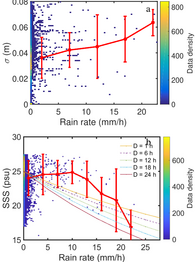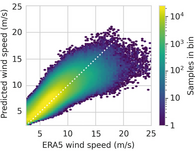Ocean and Atmosphere



GNSS-Reflectometry (GNSS-R) is an innovative remote sensing technology that leverages signals from Global Navigation Satellite Systems (GNSS) reflected off the Earth's surface to retrieve various environmental parameters, including ocean waves, wind speed, and rainfall.
GNSS-R can determine significant wave height by analyzing the reflected GNSS signals from the ocean surface. These signals provide information on the sea surface roughness, which is directly influenced by wave activity. When GNSS signals reflect off a wavy surface, the reflections become diffused, and the characteristics of these reflections are used to measure ocean and atmosphere parameters. The primary advantages of this technique are its cost-effectiveness and its suitability for implementation on small satellites. Additionally, L-band signals are less sensitive to raindrops and clouds in the atmosphere, making this method particularly useful for tracking and studying hurricanes and severe weather conditions.
GNSS-R can also detect rainfall intensity over the ocean. Rainfall affects the sea surface roughness and the dielectric properties of the water, which in turn alters the characteristics of the reflected GNSS signals. By accounting for these changes, GNSS-R systems can potentially estimate rainfall intensity.
Overall, GNSS-R offers a versatile and cost-effective means of monitoring various oceanic and atmospheric parameters. It complements existing observation techniques and provides critical data for improving weather forecasts and climate models.
References
Asgarimehr, M., Arnold, C., Weigel, T., Ruf, C., & Wickert, J. (2022). GNSS reflectometry global ocean wind speed using deep learning: Development and assessment of CyGNSSnet. Remote Sensing of Environment, 269, 112801.
Asgarimehr, M., Hoseini, M., Semmling, M., Ramatschi, M., Camps, A., Nahavandchi, H., ... & Wickert, J. (2021). Remote sensing of precipitation using reflected GNSS signals: Response analysis of polarimetric observations. IEEE Transactions on Geoscience and Remote Sensing, 60, 1-12.
Asgarimehr, M. (2020). Spaceborne GNSS reflectometry: remote sensing of ocean and atmosphere (Doctoral dissertation, Technische Universität Berlin).
Hoseini, M., Asgarimehr, M., Zavorotny, V., Nahavandchi, H., Ruf, C., & Wickert, J. (2020). First evidence of mesoscale ocean eddies signature in GNSS reflectometry measurements. Remote Sensing, 12(3), 542.
Asgarimehr, M., Wickert, J., & Reich, S. (2019). Evaluating impact of rain attenuation on space-borne GNSS reflectometry wind speeds. Remote Sensing, 11(9), 1048.
Asgarimehr, M., Zavorotny, V., Wickert, J., & Reich, S. (2018). Can GNSS reflectometry detect precipitation over oceans? Geophysical Research Letters, 45(22), 12-585.
Asgarimehr, M., Wickert, J., & Reich, S. (2018). TDS-1 GNSS reflectometry: Development and validation of forward scattering winds. IEEE Journal of Selected Topics in Applied Earth Observations and Remote Sensing, 11(11), 4534-4541.


